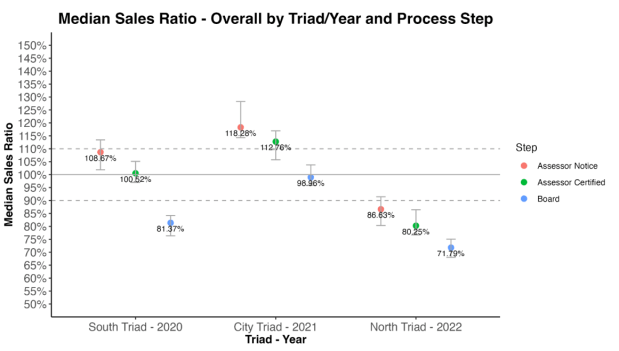An unprecedented look at Cook County’s valuation of offices, warehouses, and big apartments found that in the suburbs the values of those commercial building have been set too low, that there is little uniformity in the way they are assessed, and that appeals don’t boost the accuracy of the process.
That likely means homeowners across the county have paid more in property taxes for years to make up for the commercial shortfall.
The outside study commissioned by county board president Toni Preckwinkle’s office follows years of squabbling between Assessor Fritz Kaegi and members of the Board of Review, the two bodies that help decide how much the 1.8 million parcels in Cook County are worth and ultimately, what their owners pay in taxes.
Many of the problems highlighted in the report, officials said, predate the current officeholders, but are made worse because the two don’t share key data or communicate about their methods. The study found that on average, by the end of the three-step assessment process that concludes with the board, commercial properties in the suburbs were assessed lower than their worth.
“This is the byproduct of a system that has developed over decades and incrementally” from “years and years and years the lack of cooperation and collaboration between the two entities has led us here,” Jim Thompson, Preckwinkle’s director of property tax policy, told the Tribune Wednesday.
The analysis compared the assessor and board of review’s estimates from 2020, 2021 and 2022 against actual sale prices, a practice known as a sales ratio study.
A ratio of 100% means assessments were right on target compared to sale prices of similar properties. Anything over 100% means the assessment is higher than the market value. Below 100% means the assessment was lower than the market value. The International Association of Assessing Officers considers assessments between 90% and 110% within an acceptable range.
In the 2020 reassessment of the south suburbs, Kaegi’s first pass values were within industry standards. So were Kaegi’s second pass values, which were put out after a round of appeals to his office. But after building owners brought their cases to the Board of Review, the ratio fell to 81.37%, outside industry standards.
In suburbs north of North Avenue in 2022, Kaegi’s values were too low compared to market value from the jump, starting at 86.63%, then falling to 80.25% after his second pass. Those values fell further after board appeals, down to 71.79%.
For commercial properties in Chicago, however, Kaegi’s office initially over-valued them on first pass. Appeals to the assessor got them closer to 100% and the Board of Review knocked those values down to the appropriate level.
The study also found that in the city, as appraised value goes up, so does the rate those owners appeal and those appeals are granted. 97% of all properties worth more than $5 million in Chicago appealed to the Board of Review. Of those, 88% of all properties were granted a reduction by the board.
The study was led by Josh Myers, who runs a valuation firm that has studied several other jurisdictions and was also commissioned to study the fairness and accuracy of residential valuations in the wake of the Tribune and Propublica’s blockbuster “Tax Divide” series. Both the Tribune investigation and the outside report found widespread errors and inequities in the way former Assessor Joe Berrios valued properties.
Among the Tax Divide’s findings: Berrios often set big commercial property values too low and smaller business values too high. In the end, that meant those smaller businesses and homeowners paid more in property taxes than they should have.
Thursday’s study is the first of its kind of commercial values in Cook County and covers all three assessment cycles, for Chicago, the north and south suburbs. It also compares current practices of both offices against standards set by the IAAO.
Preckwinkle has committed to paying for similar sales ratio studies going forward, a call Kaegi has been making for several months.
Preckwinkle said both offices “have participated in this work all the way along” and that the recommendations in the report “were things that they would like to pursue.”
That’s a change from communications between the Board of Review and Assessor’s Office previously, according to the report.
Among the problems: the two have had a longstanding disagreement about how to factor in the cost of property taxes when making their valuations. They have taken different approaches to capitalization, or “cap” rates — a property’s income divided by its value — and when and how to factor them into assessments.
Analysts at the Board of Review believed Kaegi’s method didn’t correctly account for property taxes as an expense. Since they believed Kaegi’s method was “inherently in error,” the report said, it encouraged the board to fix them.
In fact, Kaegi had updated its approach in the last year, and while considered unconventional, it ultimately landed on a value that matched “professionally accepted appraisal practices,” the report found. Board analysts didn’t know that, the report said.
The report recommended the two agree on a methodology for capitalization rates.
It also recommended the assessor start formally requesting appraisals as well as data about income and expenses that are submitted to the board. While that data could help the assessor improve its accuracy, the office was not requesting it, and the board does not put it on a centralized database that both offices can use. Kaegi has been fighting for a law in Springfield that would mandate some of that data is turned over proactively, but has come up short for several years.
The report also found Kaegi rarely attended Board of Review hearings to defend his initial valuations, nor did his office regularly provide evidence to back up its assessments. A spokesman for Kaegi said they do defend assessments for high-value properties “that have the greatest impact on the tax base.”
The report recommended Kaegi start preparing “hearing packets” for commercial appeals to better make his case.
“Both offices have discussed sharing data with each other and are working on the best methods to do so,” Kaegi spokesman Christian Belanger said. “Once we have this information — which is not yet reported to us in a systematic way — we will be able to prepare the type of hearing packets the report recommends and use the information in future assessments.”
Overall, Kaegi said he supports “all the recommendations included in the report, particularly the suggestion that the Assessor’s Office and Board of Review should develop a model together to estimate tax rates used in property valuation instead of relying on outdated historical figures. Changes in this area will make the biggest difference in preventing homeowners from shouldering an unfair tax burden due to incorrect data… I look forward to working with the Board of Review to implement these recommendations as quickly as possible.”
Board of Review Commissioner Samantha Steele said she had worked to improve staff knowledge and streamlined procedures, including developing a standard appeal manual.
“We are still reviewing the data and recommendations from the PTAX report and remain committed to implementing changes that best serve Cook County taxpayers. Collaboration with my colleagues and the Assessor’s office, and all those in the property tax chain will continue to be key in this process. My goal has been and will continue to be ensuring that taxpayers are receiving fair and equitable assessments,” she said.
Commissioner George Cardenas said he agreed with the recommendations and that “better collaboration” between the board and assessor “will help each get data it needs to do its job better and make the property tax assessment system more accurate.”
The years examined in the report did overlap with the COVID-19 pandemic, which tossed commercial real estate for a loop, with higher vacancy rates at stores and offices. Myers said while he doesn’t know how much the pandemic might have affected the market, the analysts believed looking at the most recent data was more important. And the conclusions suggested systemic issues in the offices were to blame.
“I realize it’s it’s easy to look at it and say, ‘Oh well, these are pandemic years. Could they just be anomalies?’ But we have very good reason to believe that these are not anomalies, that they’re based upon practices which have been in place for a very long time that would necessarily lead to a system where the values are too non-uniform and separated from their market value,” he said.




